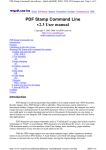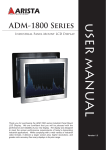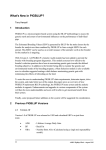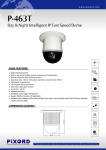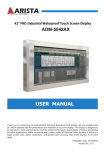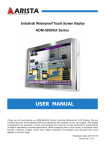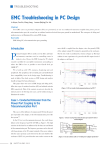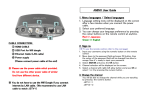Download ARD-1000 Manual
Transcript
For Evaluation Only. Copyright (c) by VeryPDF.com Inc Edited by VeryPDF PDF Editor Version 2.6 ARD-1000 VGA & RS-232 over CAT5 Extender with RGB Delay Control User Manual Safety and Notice The ARD-1000 VGA & RS-232 over CAT5 Extender with RGB Delay Control has been tested for conformance to safety regulations and requirements, and has been certified for international use. However, like all electronic equipments, the ARD-1000 should be used with care. Please read and follow the safety instructions to protect yourself from possible injury and to minimize the risk of damage to the unit. Follow all instructions and warnings marked on this unit. Do not attempt to service this unit yourself, except where explained in this manual. Provide proper ventilation and air circulation and do not use near water. Keep objects that might damage the device and assure that the placement of this unit is on a stable surface. Use only the power adapter and power cords and connection cables mduded with this unit. Do not use liquid or aerosol cleaners to clean this unit. Always unplug the power to the device before cleaning. Page.1 Introduction With only one cost effective CAT-5e cable, the ARD-1000 lets you extend VGA (WUXGA) to cover the distance up to 330m (1,000ft). The devices are composed of a transmitter and a receiver. The transmitter ARD-1000 Local Host is installed near the signal source, and the receiver ARD-1000 Remote Display is placed near the desired display. With built-in EQ and GAIN control, the transmission path can be adjusted to adapt the cable quality and video bandwidth. Furthermore, the VGA RGB delay control [de-skew] function provides the compensation among R, G, B signals due to long transmission or through normal LAN cable. In order to extend the control path, ARD-1000 also built RS-232 half-duplex long range extender along with VGA video signals. Features Supports resolution up to WUXGA (1920x1200@60Hz) Transmission distance up to 330m/1,000 feet Supports RS-232 half-duplex Adjustable equalization on Remote Display Adjustable gain control on Remote Display Adjustable RGB delay/De-skew compensation Wall Mount / DIN-RAIL Mount Page.2 Specifications & Package Contents Model Name Technical Role of usage Video bandwidth Video support Transmission Audio support RS-232 signal type Input video signal Equalization RGB delay control Loop-out ARD-1000 Local Host Transmitter [TX] Remote Display Receiver [RX] VGA connector RJ-45 connector 350MHz VESA WUXGA [1920x1200] — 330m (1,000ft) [CAT5e] No Half-duplex & baud rate 1.2 Volts [peak-to-peak] Continuous analog control Yes 1 VGA loop-out at TX [1] Human body model — ±15kV [air-gap discharge] & ±8kV [contact discharge] [2] Core chipset — ±8kV 4-layer board [impedance control — differential 100 ; single 50 ] 1x VGA 1x RJ-45 1x RS-232 1x RJ-45 1x VGA 1x VGA 1x RS-232 HD-15 [15-pin D-sub female] WE/SS 8P8C with 2 LED indicators RS-232 connector DE-9 [9-pin D-sub female] ESD protection PCB stack-up Input Output Mechanical Model Dimensions [L x W x H] Weight Package Model Package Mounting Power supply Power consumption Operation temperature Storage temperature Relative humidity Package Contents 6.19 x 4.26 x 1.35 (inch) / 157.2 x 108.4 x 34.3 (mm) 6.19 x 4.5 x 1.35 (inch) / 157.2 x 114.3 x 34.3 (mm) 10.94 x 9.37 x 3.58 (inch) / 278 x 238 x 91 mm 2.33 lbs / 1.06 kg 4.632 lbs / 2.096 kg Wall Mount / DIN-RAIL Mount 5V 2A DC 5 Watts [max] 0~50°C [32~122°F] -20~60°C [-4~140°F] 20~90% RH [no condensation] 1 x Local Host, 1 x Remote Display Two 100~220VAC input / 5VDC@2A output power adapters 6 feet modeling RS-232 cable (male to male) 6 feet modeling VGA cable (male to male) 6 feet modeling RS-232 cable (male to female) User’s Guide Page.3 Panel Descriptions ARD-1000 Local Host Front Panel 1. RS-232 IN: Connect to a RS-232 signal source (Computer) 2. VGA IN: Connect to a VGA source (Computer) Rear Panel 3. +5V DC: Power jack: connect to 5V DC power supply 4. VGA OUT: VGA loop-out to a local VGA display 5. Local OUT: Plug in a CAT-5/5e/6 cable that needs to be linked to the RJ-45 connector of the ARD-1000 Local Host unit Page.4 Panel Descriptions ARD-1000 Remote Display Front Panel 1. RS-232 OUT: Connect to a RS-232 receiving device (Touch Interface) 2. VGA OUT: VGA output to a remote VGA display Rear Panel 3. +5V DC power jack: Connect to 5V DC power supply 4. REMOTE IN: Plug in a CAT-5/5e/6 cable that needs to be linked to the RJ-45 connector of the ARD-1000 Remote Display unit 5. EQ: Rotary control for equalization of R, G, B, respectively 6. GAIN: Rotary control for gain control of R, G, B, respectively 7. Rotary control: R=0~2, G=3~5, B=6~7, for de-skew compensation on respective color channel (for RGB delay control) 8. - : Push button for decrease a level of de-skew compensation (for RGB delay control) 9. +: Push button for increase a level of de-skew compensation (for RGB delay control) Page.5 Hardware Installation 1. Connect your VGA and RS-232 source to the Local Host. 2. Connect your display and RS-232 receiving device to the Romote Display. 3. Connect your CAT-5/5e/6 cable between the Local Host and Romote Display units. 4. Make sure your CAT-5/5e/6 cable is tightly connected and not loose. 5. Plug in 5V DC power cord to the power jack of the Romote Display. 6. Plug in 5V DC power cord to the power jack of the Local Host. Page.6 For Evaluation Only. Display CopyrightAdjust (c) by VeryPDF.com Inc Quality Edited by VeryPDF PDF Editor Version 2.6 1. If a blurred video is seen or even worse, not displayed at all, try to adjust the EQ and Gain rotary controls to improve the cable skew. GAIN rotary controls are designed for gain control, and EQ rotary controls are designed for equalizing the wave form of the receiving video signal. It is suggested to begin with adjusting the rotary control of EQ to get the input video displayed first, and then the GAIN according to the video you see on the screen. 2. RGB delay control [De-skew] offers the flexible functionality to allow skew compensation among VGA R, G, B signals due to long transmission or thru low quality cable. By adjusting the rotary switch to choose R, G or B color channel at first, then use the push buttons to increase or decrease the delay in the corresponding color channel. There are totally 31 steps, each step with 2ns difference, for adjusting the delay between each color individually. Then the graphics quality can be further assured. Suggested test pattern to adjust EQ and GAIN: You can download this pattern from Arista web site link: http://www.goarista.com/download/test_ pattern.zip Page.7 VGA over CAT5 Extension CAT-5 cable provides an enormous cost benefit over coax. The average cost of 100 meters of CAT-5 cable is $20 while the average cost of 100 meters of coax cable could easily exceed $240. Furthermore, wiring is reduced from a bulky bundle of cables to 1 easily pulled cable. Let us also have a look at the characteristics of CAT-5 type cable before we go deeper on the topic. Standard CAT-5 cable consists of 4 twisted pairs of AWG 24 cable, which has a characteristic impedance of 100 ohm. The DC resistance is 10 ohm / 100 m with a capacitance of 4.6nF/100 m. The figure below demonstrates the losses within CAT-5 cable! In order to transmit the VGA over CAT-5, differential signal transmission is considered for almost all of VGA over CAT-5 extenders. Because of the low bandwidth of the cables, on the receiver is inevitable. Appropriate compensations such as equalization and gain control, and even delay adjustment among component colors are a necessary means in order to get at least acceptable quality of video and audio. Performance Guide for VGA over LAN Cable Transmission Page.8 Common Video Problems (Ref.Intersil) Ghosting Ghosting always occurs horizontally and to the observer’s right following the path of the video signals. To avoid reflections and maintain integrity of the input video signals over long CAT-5 cables, each stage must be properly terminated. Common-mode Noise Common mode noise can cause a loss of synchronization because the sync signals are typically transmitted common-mode. The example shows loss of horizontal synchronization. Page.9 Common Video Problems (Ref.Intersil) Color Mismatch Color mismatch is the effect of a difference in gain or offset of the color channels. Example shows the screen on the bottom has excess blue. Power Supply Noise Power supply noise appears as a repetitious disturbance in the video picture. Use a higher quality voltage regulator to power the amplifiers and bypass all chipsets as close to the power pins as possible. Page.10 Common Video Problems (Ref.Intersil) Channel Timing Mismatch If the R, G, and B signals are mismatched with respect to time, they will cause a blurring of the signal. Smearing Equalization issues are necessary when using CAT-5 cables to transmit VGA signals. Compensation is needed to rectify the high frequency losses of the system. Page.11 How to select VGA extenders over CAT-5: Since the lossless transmission is impossible for such a kind of converters, there are a couple of key factors while evaluating these modules. First of all, it is about the signal bandwidth. Fundamentally, the higher the bandwidth, the better it is supposed to be. Secondly, the slew rate! The slew rate represents the maximum rate of change of a signal at any point in a circuit. Limitations in slew rate capability can give rise to non linear effects in electronic amplifiers. These two factors above are especially important while designing TX unit, because the receiver cannot do much on improving the distortion of the resulting video caused by low quality amplifiers on transmitters. Because of the low bandwidth and low quality of CAT-5 in the most cases, the received video is expected to be distorted seriously. One good VGA over CAT-5 extender should at least be capable of equalizing the received differential video signal to some extent. Basic functions like equalization and gain controls are designed for this purpose. Depending upon the ability of equalization and gain compensation, smearing, ghosting, and color mismatch may be eliminated or ameliorated. To further improve the resulting video quality, the functionality of de-skewing is essential. Again, due to the quality of CAT-5 type cables, the arrival time of the component colors R, G, B is basically different especially thru the long distance transmission. Therefore the channel timing mismatch is inevitable. VGA over CAT-5 extenders with delay control could be the best choice to guarantee the video quality for very long distance transmission applications. Page.12 Limited Warranty The Arista Corp. warrants the ARD-1000 VGA & RS-232 over CAT5 Extender with RGB Delay Control to be free from defects in the material and workmanship for 2 year from the date of purchase from the Arista Corp. or an authorized dealer. Should this product fail to be in good working order within 2 year warranty period, The Arista Corp., at its option, repair or replace the unit, provided that the unit has not been subjected to accident, disaster, abuse or any unauthorized modifications including static discharge and power surges. Unit that fails under conditions other than those covered will be repaired at the current price of parts and labor in effect at the time of repair. Such repairs are warranted for 90 days from the day of reshipment to the BUYER. If the unit is delivered by mail, customers agree to insure the unit or assume the risk of loss or damage in transit. Under no circumstances will a unit be accepted without a return authorization number. The warranty is in lieu of all other warranties expressed or implied, including without limitations, any other implied warranty or fitness or merchantability for any particular purpose, all of which are expressly disclaimed. Proof of sale may be required in order to claim warranty. Customers outside Taiwan are responsible for shipping charges to and from the Arista Corp.. Cables are limited to a 30 day warranty and cable must be free from any markings, scratches, and neatly coiled. The content of this manual has been carefully checked and is believed to be accurate. However, The Arista Corp. assumes no responsibility for any inaccuracies that may be contained in this manual. The Arista Corp. will NOT be liable for direct, indirect, incidental, special, or consequential damages resulting from any defect or omission in this manual, even if advised of the possibility of such damages. Also, the technical information contained herein regarding the ARD-1000 features and specifications is subject to change without further notice. Copyright 2009 ARISTA. All rights reserved. All trademarks are the property of their respective owners. Page.13















